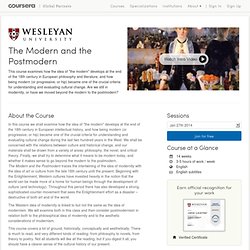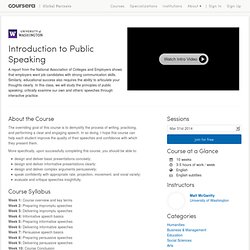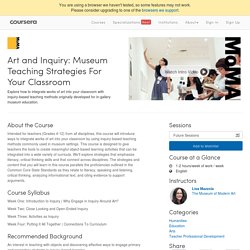

The Modern and the Postmodern. In this course we shall examine how the idea of "the modern" develops at the end of the 18th century in European intellectual history, and how being modern (or progressive, or hip) became one of the crucial criteria for understanding and evaluating cultural change during the last two hundred years in the West.

BerkeleyX: Stat2.3x Introduction to Statistics: Inference. Philip B. Stark Philip B. Stark is Professor of Statistics at University of California, Berkeley where he developed the university's first online course. Online Games: Literature, New Media, and Narrative. About the Course Intended for both newcomers who are curious about video games and experienced gamers who want to reflect on their passion, this course will explore what happens to stories, paintings, and films when they become the basis of massively multiplayer online games.

The Lord of the Rings trilogy—the novels, films, and video game—are our central example of how “remediation” transforms familiar stories as they move across media. The course is designed as a university-level English literature class—a multi-genre, multimedia tour of how literature, film, and games engage in the basic human activity of storytelling. Our journey will enable us to learn something about narrative theory, introduce us to some key topics in media studies and cover some of the history and theory of video games.
It will also take us to some landmarks of romance literature, the neverending story that lies behind most fantasy games: J.R.R. Introduction to Public Speaking. About the Course The overriding goal of this course is to demystify the process of writing, practicing, and performing a clear and engaging speech.

In so doing, I hope this course can help each student improve the quality of their speeches and confidence with which they present them. More specifically, upon successfully completing this course, you should be able to: design and deliver basic presentations concisely; design and deliver informative presentations clearly; design and deliver complex arguments persuasively; speak confidently with appropriate rate, projection, movement, and vocal variety; evaluate and critique speeches insightfully.
Course Syllabus Recommended Background If you wish to complete the three speech assignments, you must have access to video recording equipment (e.g., digital camera, cell phone, flip camera, webcam, or video camera) and the ability to share this digital content via YouTube, Vimeo, or Aparat. In-course Textbooks. Nutrition for Health Promotion and Disease Prevention. Module 1: Introduction to Nutrition Science If you are what you eat, you should probably know something about how to eat!

In this introductory module, you will learn about the field of nutrition science, the basics of nutrition research and some important terms that will set the stage for the remainder of the class. This module ends with a global look at meal planning guides and tools and provides you with an opportunity to determine your own individual nutrient needs. Module 2: Heart Disease Heart disease is the number one cause of death around the world. Module 3: Diabetes Globally, it is estimated that 438 million people – or roughly 8% of the world’s population – will have diabetes by 2030. Module 4: Cancer Diet and cancer are certainly linked; but the degree to which food intake impacts the development and progression of cancer is still not entirely understood.
Module 5: Obesity and Weight Management Global statistics for obesity did not exist 50 years ago. Yes. Yes. Art and Inquiry: Museum Teaching Strategies For Your Classroom. About the Course Intended for teachers (Grades 4-12) from all disciplines, this course will introduce ways to integrate works of art into your classroom by using inquiry-based teaching methods commonly used in museum settings.

This course is designed to give teachers the tools to create meaningful object-based learning activities that can be integrated into a wide variety of curricula. We'll explore strategies that emphasize literacy, critical thinking skills and that connect across disciplines. The strategies and content that you will learn in this course parallels the proficiencies outlined in the Common Core State Standards as they relate to literacy, speaking and listening, critical thinking, analyzing informational text, and citing evidence to support arguments. Course Syllabus Week One: Introduction to Inquiry | Why Engage in Inquiry Around Art? Week Two: Close Looking and Open-Ended Inquiry Week Three: Activities as Inquiry Recommended Background Suggested Readings. Cryptography I.